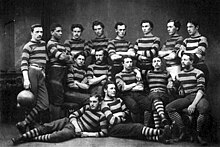Royal High School, Edinburgh
[8][9] In 1566, following the Reformation, Mary, Queen of Scots, transferred the school from the control of Holyrood Abbey to the Town Council of Edinburgh.[10] In 1584 the Town Council informed the rector, Hercules Rollock, that his aim should be "to instruct the youth in pietie, guid maneris, doctrine and letteris".[14] The Romantic era at the turn of the 19th century was for Scotland a golden age of literature, winning the Royal High School an international reputation and an influx of foreign students, among them French princes.[15] The historian William Ross notes: "Walter Scott stood head and shoulders above his literary contemporaries; the rector, Alexander Adam, held a similar position in his own profession."[16] By the end of the Napoleonic Wars, an old scholar remembered, 'there were boys from Russia, Germany, Switzerland, the United States, Barbadoes, St. Vincent, Demerara, the East Indies, besides England and Ireland.The school blazer is a compulsory part of the uniform and children are allowed to wear other jackets as long as they are not worn inside the building.When full colours are awarded to a pupil a new pocket is attached to the blazer with the school emblem embroidered in silver wire with the dates of the present academic year either side of the badge.The Royal High School armorial bearings derive from the shield of the city arms, and antedate the Act of Parliament on the subject in 1672.The description reads: 'Sable, a castle triple towered and embattled argent, masoned of the first, windows and doors open gules set upon a rock proper.Above the shield is placed a helmet befitting its degree with a mantling sable doubled argent and in a scroll over the same this motto Musis Respublica Floret (The State Flourishes with the Muses).[46] At first the organisation of the games was undertaken by the masters, but at the request of the rector, James Donaldson, the burden was assumed by the cricket club, which carried it until the outbreak of the First World War.Conceived as a character-building exercise, the annual games and nations system were intended to foster a team spirit and encourage physical activity among all pupils.Within each nation, masters were appointed to committees to develop Under 15 and Under 13 cricket and rugby teams, and to broaden participation beyond the First XI and XV by training pupils of every level of ability.[47] The competitive scheme proved popular with pupils and teachers and has since been expanded to encompass a wide variety of games, sports and other extracurricular activities, held throughout the year.[53] However, because the traditional cohort system was governed by independent masters with separate student followings, the club classes did little to foster a common school spirit.The first annual report, dated July 1850, contains the original constitution,[57] clause IV of which states: 'The objects of the Club shall be generally to promote the interests of the High School, maintain a good understanding, and form a bond of union among the former Pupils of that institution.The Royal High School (Canada) Club was formed in Winnipeg in 1914, and after lapsing into inactivity because of the war it was revived in British Columbia in 1939.It features news and creative input from all sections of the school community, including regular club reports and interviews with famous former pupils.Among the Royal High School's appearances in literature are the stories related in the Gentleman's Magazine, Walter Scott's Autobiography, Lord Cockburn's Memorials, Captain Basil Hall's Log Book of a Midshipman, George Borrow's Lavengro, George M'Crie's 1866 poem The Old High School,[70] and William Boyd's The New Confessions.It dramatises the fatal shooting during the siege of a chief magistrate, John Macmoran, by a pupil, William Sinclair, a grandson of the Earl of Caithness.








Old Royal High SchoolEdinburghco-educationalschoolCity of Edinburgh CouncilBlackhall primary schoolClermiston primary schoolCramondDavidson's MainsState schoolNon-denominational ChristianAlwin, Abbot of HolyroodEdinburgh CitypurpleVivas Schola RegiaeducationCertificate of Secondary EducationsettingEnglishmathematicsEuropean StudiesInternational BaccalaureateEducation ScotlandRegent RoadFirst World Waroldest school in the world12th century renaissanceseminaryHolyrood AbbeyAugustiniancanonsDavid Ichurchlandedburgesshigh schoolEnglandReformationMary, Queen of ScotsTown Council of EdinburghJames LawsonJames VIHercules Rollockgeographyegalitarian spiritclassical traditionScottish EnlightenmentRomantic eraWalter ScottAlexander AdamNapoleonic WarsRussiaGermanySwitzerlandUnited StatesBarbadoesSt. VincentDemeraraEast IndiesEnglish High School of BostonFrenchfencinggymnasticsGermansciencedrawingmilitary drillswimminghistoryVennel of the Church of St. Mary in the FieldsCardinal Beaton'sCollegiate Church of St. GilesRegent Road buildingCalton HillJock's LodgeRoyal Terrace1939–1945 warBarntoncomprehensivepublic-private partnershipAmey plcuniversitySuttonHigher gradesUniform of the Royal High Schoolarmorial bearingsshield of the city armsParliamentLord LyonSchool songRoyal HSFPCouncilMagna CartaCricketFootballsportingRugby FootballAthleticQueen VictoriaJames DonaldsonWilliam J. Watsonschool housesAnglesBritonssportsclackenEdward VIILeonhard SchmitzList of people educated at the Royal High School, EdinburghRobert AdamAlexander Graham BellHenry Peter BroughamEric Brown (pilot)Ian CharlesonChariots of FireGandhiRobin CookThomas CouttsRonnie CorbettJohn CruickshankThomas DohertyHenry DundasRobert FergussonEric LomaxThe Railway ManJohn Menzies